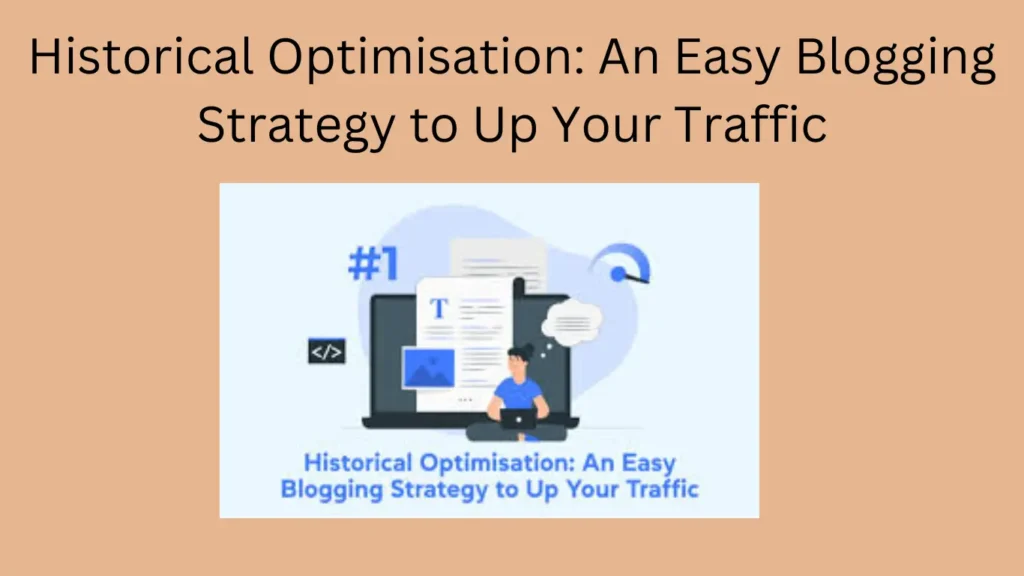What possible use could history have for online marketers and proprietors? As goal-driven business people, we are preoccupied with the future, but it is in the past.
Our goal is to surpass our previous achievements by producing and refining fresh material. Many of us can become distracted by the future and overlook an important asset that is buried behind the layers of time: the historical information stored in our archives.
What is Historical Optimisation
A approach to increase traffic and leads from your current blog content is historical optimization. You can still get more traffic from a piece you published five years ago or last month.
How much more traffic?
According to Hubspot, improving their older content increased traffic by more than 100%.A performance like that could be a game changer if you use blogging as a marketing channel.
So, how do you optimise the past?
A time machine is not necessary for optimizing historical content. It just requires a few basic tools and methods. Follow this strategy to make the most of the past and return to the future with success.
Actions to Take Prior to Optimizing Old Content: Invest some effort in improving technical aspects like crawlability, mobile friendliness, page speed, and other problems that degrade user experience and could impact your SEO ranking.
you shouldn’t let historical optimization deter you from producing fresh material. Adopt a hybrid strategy and divide your time and energy between previously published and unpublished material.
Steps for Optimising Historical Content
Identify Under performing Blog Posts
You might be able to optimize hundreds of posts if you’ve been writing for a while. If you want to avoid wasting time, it’s critical to give content that needs to be updated priority.
Enter Google Search Console and access the information on performance. Based on their titles and target keywords, are there any older blog pages that you think could perform better? List the posts that are not doing well but have the potential to generate a lot of revenue.
Find High Intent Keywords That Are Missing
Determine the pertinent keywords for every historical article and adjust the material appropriately. Conduct keyword research using tools like Google Keyword Planner or SEMrush to identify keywords with a decent search volume and minimal competition.
Revise Outdated Data
Check each historical item for correctness and applicability. Any out-of-date data, figures, or references that are no longer accurate should be updated or removed.
Make sure the information represents the most recent advancements and trends in the business. To keep the content looking current, add case studies, new examples, and external connections.
Boost Readability and Formatting
Improve the formatting and organization of older information to make it easier to read. Large passages of text should be broken up into smaller paragraphs, information should be organized using subheadings, and bullet points and numbered lists should be used when necessary.
Use distinct headings and emphasize key themes to make the information easy to scan.
Incorporate and Revise Graphical Components
To improve the visual appeal and social media shareability of your historical content, think about incorporating pertinent photos, infographics, or films.
To ensure that your images and videos show up in image and video searches, give all of your images and films keyword-rich alt descriptions.
Revise Internal Connections
Use internal linking to establish a connection between older material and more recent pages or articles. Within your historical information, find pertinent anchor text and use it to connect it to other pertinent pages on your website.
By giving users more context and resources, this not only makes it easier for search engines to find and index your material but also enhances the user experience overall.
For further Inquires Contact Us
FAQs
1. What is historical optimization in blogging?
Historical optimization is the process of updating and improving old blog content to make it more relevant, valuable, and optimized for search engines. It involves updating outdated information, improving formatting and readability, and optimizing for target keywords.
2. Why is historical optimization important for bloggers?
Historical optimization is important for bloggers because it allows them to make the most of their existing content by keeping it up-to-date and relevant. It can help improve search engine rankings, increase organic traffic, and enhance the overall quality of their blog.
3. How do you identify which blog posts to optimize historically?
To identify blog posts for historical optimization, bloggers can use analytics tools to identify high-traffic but outdated posts, posts that are ranking on the second page of search results, or posts that are relevant but not performing well. They can also consider updating posts that cover evergreen topics or have outdated information.
4. What are some strategies for effectively optimizing old blog content?
Some strategies for effectively optimizing old blog content include updating statistics and facts, adding new information or insights, improving readability and formatting, optimizing for new keywords, adding relevant images or videos, and promoting the updated content through social media and email newsletters.
5. How can historical optimization impact a blog’s traffic and SEO?
Historical optimization can have a positive impact on a blog’s traffic and SEO by improving the visibility and relevance of old blog posts. By updating and optimizing old content, bloggers can attract new readers, improve search engine rankings, and increase organic traffic over time.
